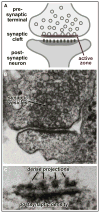The presynaptic active zone
- PMID: 22794257
- PMCID: PMC3743085
- DOI: 10.1016/j.neuron.2012.06.012
The presynaptic active zone
Abstract
Neurotransmitters are released by synaptic vesicle exocytosis at the active zone of a presynaptic nerve terminal. In this review, I discuss the molecular composition and function of the active zone. Active zones are composed of an evolutionarily conserved protein complex containing as core constituents RIM, Munc13, RIM-BP, α-liprin, and ELKS proteins. This complex docks and primes synaptic vesicles for exocytosis, recruits Ca(2+) channels to the site of exocytosis, and positions the active zone exactly opposite to postsynaptic specializations via transsynaptic cell-adhesion molecules. Moreover, this complex mediates short- and long-term plasticity in response to bursts of action potentials, thus critically contributing to the computational power of a synapse.
Copyright © 2012 Elsevier Inc. All rights reserved.
Figures





References
-
- Ackley BD, Harrington RJ, Hudson ML, Williams L, Kenyon CJ, Chisholm AD, Jin Y. The two isoforms of the Caenorhabditis elegans leukocyte-common antigen related receptor tyrosine phosphatase PTP-3 function independently in axon guidance and synapse formation. J Neurosci. 2005;25:7517–7528. - PMC - PubMed
-
- Akert K, Pfenninger K, Sandri C, Moor H. Freeze-etching and cytochemistry of vesicles and membrane complexes in synapses of the C.N.S. In: Pappas GD, Purpura DP, editors. Structure and Function of Synapses. New York: Raven Press; 1972. pp. 67–86.
-
- Altrock WD, tom Dieck S, Sokolov M, Meyer AC, Sigler A, Brakebusch C, Fässler R, Richter K, Boeckers TM, Potschka H, et al. Functional inactivation of a fraction of excitatory synapses in mice deficient for the active zone protein bassoon. Neuron. 2003;37:787–800. - PubMed
Publication types
MeSH terms
Substances
Grants and funding
LinkOut - more resources
Full Text Sources
Other Literature Sources
Miscellaneous

